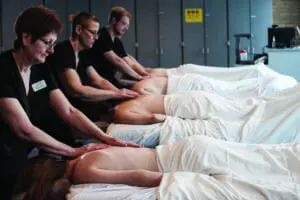7 Important Questions to Ask About Massage Therapy Careers
Massage therapy careers are filled with opportunity. Not only will you join the growing healthcare field, but you’ll also help improve people’s health and well-being. If you’re thinking about massage therapy as a career path, you should know that this is a great time to join the profession.
Below, we delve into what massage therapy careers can involve and also highlight why massage therapy is a great career choice. We’ll cover the following:
- The basic definition of a massage therapist
- The job outlook for a massage therapist and information on salary
- The advantages to a massage therapy career path
- The qualities to have as a massage therapist
- The steps it takes to become a massage therapist
1. What is a massage therapist?
A massage therapist is a trained professional that practices the manual, or hands-on, movement of soft body tissues to enhance a person’s well-being. (Soft body tissues include muscle, connective tissue, tendons, and ligaments.)
Massage therapy can help people in a variety of ways:
- Reduce stress and anxiety
- Relax muscles
- Rehabilitate injuries
- Help manage pain
- Promote overall health and wellness
Massage therapists are playing an increasingly important role in healthcare. More on that below.
If you’re interested in a healthcare-related career, you should note that massage therapy training programs vary. For example, the massage therapy school at Northwestern Health Sciences University (NWHSU) focuses on preparing massage therapists to be healthcare professionals in integrative healthcare settings.
2. What is the job outlook for massage therapists?
Numerous factors indicate a promising future for massage therapists and the field of massage therapy in general.
A rapidly expanding job market
The Bureau of Labor Statistics estimates a 18 percent job growth rate between 2023 – 2032 for massage therapists. (The U.S. job growth rate average for all occupations is 5 percent.)
A demand for alternative approaches to pain management
Because of the painkiller/opioid crisis, more healthcare practitioners and their patients are looking for non-invasive, drug-free approaches to pain management—like massage therapy.
According to Consumer Reports, The American College of Physicians includes massage therapy in its list of recommendations for lower back pain.
Based on surveys conducted by the American Massage Therapy Association (AMTA), 88% of adult Americans believe that massage can help with pain reduction.
Note that the demand will likely remain strong as the general population continues to age—and as more people discover the benefits of natural, non-drug healthcare approaches such as massage therapy.
A growing body of research supporting the benefits of massage therapy
Research continues to demonstrate the effectiveness of massage therapy for pain. For example, the journal Pain Medicine states there is “clear evidence supporting the efficacy of massage therapy” as a pain management option.
And that efficacy extends to mental health as well. The AMTA points to a number of studies demonstrating that massage can help those with anxiety, and The Journal of Clinical Psychiatry has shown evidence that massage can alleviate certain symptoms of depression.
Wider acceptance within the healthcare industry
Patients are receiving more massage therapy referrals and recommendations. Surveys conducted by the AMTA show an increase in medical doctors, chiropractors, and other healthcare providers suggesting massage to their patients.
Also, as integrative models of healthcare become more and more common, opportunities for massage therapists in the healthcare field will continue to grow.
Here are just a few prominent examples of how massage therapy is becoming an integral part of large-scale—and influential—healthcare providers, as detailed in a recent report by the AMTA:
- Mayo Clinic has been a true leader in integrating massage therapy into its inpatient and outpatient services since 2002.
- Memorial Sloan Kettering Cancer Center in New York City employs licensed massage therapists in various departments.
- Michigan’s largest healthcare system, Beaumont Health, began a massage therapy program in its oncology department 15 years ago. That program has now expanded to numerous departments and the provider now has dozens of licensed massage therapists on staff.
Rise in health insurance coverage
Here’s another positive sign for the future of massage therapy. The AMTA states that insurance plans that include massage therapy are becoming more common.
This trend will likely continue, especially considering that 59% of consumers, according to the AMTA, say they would like to see massage therapy covered by their health insurance.
3. What are some unique advantages to a career as a massage therapist?
Being a massage therapist gives you a number of career benefits. Consider the following examples.
Help people and be appreciated.
As a massage therapist, you can enjoy a profession where people truly look forward to seeing you and receiving your care. You also experience the satisfaction of helping ease people’s physical pain, making them feel more relaxed, or just providing a valuable source of human connection through touch.
Work in a low-stress environment.
Some healthcare settings can be hectic and stressful. As a massage therapist, you can work in an atmosphere with much lower stress levels.
Enjoy the deeper patient connection that can come with massage therapy.
Rather than move a person quickly through an appointment, a massage therapist provides direct care through touch, sometimes for an hour or more.
Be part of the healthcare solution.
Massage therapy is poised to play an integral role in healthcare’s evolution. As a massage therapist, you can be a key player in the growing need for more drug-free and less invasive means to administer healthcare treatment.
Watch NWHSU’s Dr. Michele Renee discuss the massage therapy profession.
Work alongside fellow healthcare providers. With the appropriate training and credentials, you can work with acupuncturists, chiropractic doctors, medical doctors, nurses, physical therapists, and others in the healthcare industry.
Enjoy more autonomy. The massage therapy profession can offer a higher degree of freedom compared to other healthcare professions. Self-employment is a viable—and popular—choice for many massage therapy graduates. This also makes it easier to have a more flexible schedule and a more satisfying work/life balance.
Have options that allow you to specialize. As a massage therapist, you can develop an expertise and focus on specific client populations. Pregnant women, children, cancer patients, elders, hospice patients, veterans, athletes—these are just a handful of examples.
Watch former NWHSU student Janet Kadlec describe her work as a massage therapist at a hospice facility.
Establish a solid foundation for furthering your healthcare career. Massage therapy training and education can provide an excellent foundation of knowledge in health and the human body. Some massage therapists choose to expand this knowledge to eventually become chiropractors, acupuncturists, nurses, and more.
4. What should you know about a massage therapist’s salary or yearly income?
Larry Morgan of the Orion HR Group, a human resources consulting firm specializing in compensation analysis, reports the following average massage therapist salary information for the Minneapolis-St. Paul metro area as of May 2020.
Note that these salaries are for W-2 employees and do not reflect the income of massage therapists who own/operate their own business:
- Graduate to one year experience: $42,000 annually, with data varying from $39,000 to $45,100
- 10+ years experience: $52,850 annually, with data varying from $46,000 to $59,700
Many variables go into formulating reliable salary estimates. That’s why providing a single nationwide number is not the most accurate way to understand what a massage therapist earns.
5. Where do massage therapists work?
In what kind of environment do you see yourself working? As a massage therapist, you have an exceptionally wide range of choices. Here are some examples:
- Your own private practice
- Integrative care clinics
- Chiropractic offices
- Community clinics
- Primary care clinics
- Private hospitals
- VA medical centers
- Corporate settings
- Wellness centers
- Fitness centers
- Spas
- Luxury hotels
- Sports team facilities
- Cruise ships
See former NWHSU student Rachel Roller talk about her role as a massage therapist in a chiropractic and wellness center.
6. What qualities should you have to be a massage therapist?
Is a career in massage therapy right for you? During your massage therapy training, you’ll likely acquire helpful knowledge of the body and important technical skills to administer massage.
But there are also other considerations. As you explore the possibility of being a massage therapist, keep qualities like the following in mind:
You want to help people. When you imagine a career, is the idea of helping others one of the first things you think about? As a massage therapist, you can experience making a meaningful impact on people every day.
You like the idea of providing hands-on care to people. Are you the one giving shoulder rubs at family get-togethers? You may have a natural gift! A career as a massage therapist empowers you to take that gift to the professional level.
You want to play a role in the future of healthcare. Healthcare is changing. Natural, non-invasive, and drug-free healthcare treatment options are more important than ever. If that sounds exciting to you, then a massage therapist career could be a great fit.
You have an entrepreneurial spirit. Though not every massage therapist wants or needs to have their own practice, many do. Some love the independence of being an owner/operator and are open to taking on additional responsibilities like billing, marketing, and office administration.
Watch former student Jason Erickson explain his experience at NWHSU and how it inspired him to open a clinic of his own.
7. What are the official requirements for starting a career as a massage therapist?
Generally speaking, the basic steps to becoming a massage therapist involve:
- Applying to a massage therapy school
- Completing coursework and hands-on massage training through the massage program
- Passing a licensing examination and/or obtaining the required certification
- Applying for a license in the given state or jurisdiction you plan to practice
If you’re considering a career as a massage therapist, it’s important to understand that there can be several different types of massage therapy credentials.
For example, at NWHSU your options include the following:
- Certificate in Relaxation Massage. This prepares you for work environments such as spas, salons, and massage therapy franchises. (Note that this certificate does not necessarily limit you to these settings.)
Certificate in Therapeutic Massage. This prepares you for work in health clubs and athletic facilities, as well as healthcare settings such as hospitals, integrative clinics, and chiropractic offices. It also prepares you to run a private massage therapy practice. (Note that this certificate does not necessarily limit you to these settings.)
Associate of Applied Science in Massage Therapy (A.A.S.). The A.A.S. degree option expands upon the coursework in therapeutic massage (see above) and includes general education courses. This option also opens up additional opportunities for further education and professional advancement.
East West Therapeutic Massage Certificate – The East West Therapeutic Massage Certificate program combines the therapeutic techniques of Eastern Chinese Medicine (Shiatsu) and Western massage therapy to treat the whole person, equipping you with additional tools for assessing and treating patients as part of an integrative healthcare team.
Shiatsu Certificate – The Shiatsu Certificate is designed for those with previous massage therapy experience who want to expand their practice to include Eastern medicine, specifically Shiatsu: Japanese bodywork grounded in traditional Chinese medicine.
At NWHSU, depending on the program you choose, it will take 2 to 5 trimesters (or 7½ to 19½ months) to complete.
So how do we know so much about massage therapy careers? Northwestern Health Sciences University is a leader in massage therapy education.
We are a mission-driven university, preparing the next generation of healthcare professionals to not only deliver, but also advance healthcare.








